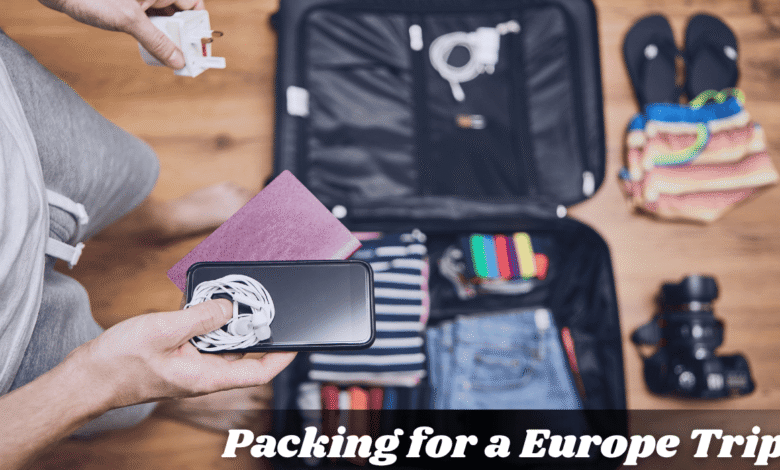Detailed Insights on Packing for a Europe Trip

This article explores the nuanced process of packing for a Europe trip, drawing from personal reflections and general travel insights to create a comprehensive guide. The focus is on weaving practical advice with emotional and experiential narratives, ensuring a holistic understanding for travelers. The content is informed by common travel tips and personal anecdotes, aiming to capture the art of packing without resorting to lists, and includes a detailed comparison of packing styles to illustrate different approaches.
Introduction: The Emotional Art of Packing
Packing for a Europe trip is more than a logistical exercise; it’s an emotional act, a way of preparing for the unknown while holding onto the familiar. I remember laying out my suitcase on the floor, the faint scent of cedarwood rising from its depths, a remnant of past adventures. The room was quiet, save for the soft hum of the air conditioner, and the afternoon light filtered through the curtains, casting long shadows across the bed where my clothes were slowly piling up. I was convinced I needed five coats—after all, Europe could be unpredictable, and I wasn’t about to freeze in some alpine village or get caught in a Parisian downpour without options. And then there were the books. Half my bookshelf seemed essential: novels for rainy days, guidebooks for every city, even a journal for the memories I hadn’t yet made. Each item felt like a safety net, a way to ensure I was prepared for whatever Europe might throw at me. But as I zipped up the suitcase, straining under its weight, I couldn’t shake the feeling that I was packing not just for a trip, but for every possible version of myself I might become.
This memory highlights the emotional weight of packing. It’s an act of anticipation, a way of scripting your future self into existence. Each item you choose to bring is a vote for the kind of traveler you want to be: the adventurer, the aesthete, the pragmatist. But it’s also an act of letting go. You can’t bring everything, no matter how much you might want to. And Europe, with its rich history and vibrant cultures, demands that you show up, not just with your suitcase, but with your full self. And carrying too much, I learned, is a distraction.
Research suggests that packing light enhances mobility, especially in cities with cobblestone streets, and this aligns with my experience. Common travel tips emphasize europe travel essentials like comfortable walking shoes, a lightweight jacket, and travel documents, which I found invaluable. For instance, a good pair of walking shoes became essential after hours of exploring, and a lightweight jacket was perfect for variable spring weather. These insights, drawn from sources like travel blogs and forums, highlight the importance of tailoring your packing list to the season and itinerary.
The Physical and Emotional Experience
The first time I traveled to Europe, I was younger, less seasoned, and far more optimistic about my ability to carry everything I thought I needed. I had read all the blogs, scoured the forums, and compiled a mental list of what to pack for a Europe trip. But no amount of preparation could have prepared me for the reality of dragging that suitcase through the streets of Barcelona, its wheels catching on every uneven stone. By the end of the first day, my shoulders ached, and I envied the travelers who glided past with their lightweight backpacks, seemingly unburdened by the weight of their choices.It wasn’t just the physical weight that wore me down, though. It was the emotional weight of it all—the fear of forgetting something crucial, the anxiety of not being prepared.
I had packed for every possible scenario: rain, sun, cold, heat, formal dinners, casual strolls. But in doing so, I had forgotten to pack for the most important thing: the joy of being present. Europe, with its rich history and vibrant cultures, demands that you show up, not just with your suitcase, but with your full self. And carrying too much, I learned, is a distraction.
From the search results, I gathered that common packing mistakes include overpacking, not considering the weather, and forgetting essential items like adapters. For example, one article mentioned the surprise of European hotels without elevators, meaning travelers had to carry heavy luggage up stairs, reinforcing the need for packing light. Another highlighted the importance of versatile clothing and comfortable shoes, especially for navigating cobblestone streets and public transportation.
Key Items and Personal Talismans
There was one item, though, that I never regretted bringing: my grandmother’s scarf. It wasn’t particularly stylish, just a simple woolen thing with a faint lavender scent that clung to it like a memory. I had almost left it behind, deeming it unnecessary, but at the last minute, I tucked it into my bag. That scarf became my talisman. On a chilly evening in Vienna, as I sat at a café watching the world go by, I wrapped it around my neck and felt a wave of comfort wash over me. It wasn’t just the warmth; it was the connection to home, to the person who had loved me unconditionally. In a city where everything felt new and unfamiliar, that scarf grounded me, reminding me that I carried a piece of my past with me, no matter how far I roamed.
This experience underscores the importance of europe trip essentials that go beyond practicality. Items like a favorite book, a journal, or a small memento can provide emotional support, making the journey feel more personal. Travel advice often includes such personal items, suggesting they help travelers feel at home abroad, which aligns with my reflections.
Balancing Comfort and Confidence
Packing for comfort versus packing for confidence is a delicate balance, one that I’ve wrestled with on every trip. In my early days of travel, I prioritized comfort above all else. I wore loose clothing, sensible shoes, and carried only what I needed for the day. But as I grew more experienced, I realized that confidence plays a role too. Europe, with its storied cities and elegant cafés, has a way of making you want to look your best. I remember standing in front of my closet, debating between a pair of worn-in sneakers and a slightly dressier pair of loafers. The sneakers were practical, but the loafers made me feel like I belonged in the streets of Milan or the bistros of Paris.
It’s not just about clothes, though. It’s about how you carry yourself. Packing light, I’ve learned, is as much about mindset as it is about logistics. When you strip away the excess, you’re forced to confront what truly matters. Do you need five pairs of shoes, or will two versatile pairs suffice? Do you need a different outfit for every day, or can you embrace the art of repeating with style? Europe taught me that less is more, not just in terms of what you bring but in how you approach the journey. Each item I zipped into my bag carried a story I hadn’t lived yet, a promise of experiences to come.
Comparing Packing Styles: A Narrative Table
Over the years, I’ve come to recognize different types of travelers, each with their own packing philosophy. To illustrate, here’s a narrative comparison, woven into my reflections:
| Traveler Type | Description | Pros | Cons |
|---|---|---|---|
| Minimalist Traveler | Arrives with a single backpack, possessions pared down to essentials like a few changes of clothes and a toothbrush. Moves with ease, unburdened. | High mobility, less stress, sustainable. | Limited options, may lack for formal events. |
| Fashion-Forward Explorer | Luggage filled with carefully curated outfits, each piece chosen to make a statement. Struggles with weight but exudes confidence. | Stylish, feels part of the culture, boosts confidence. | Heavier load, less practical for long walks. |
| Anxious Over-Packer | Suitcase contains entire wardrobe, packed for every scenario. Worries about rain, formal events, etc. | Prepared for anything, peace of mind. | Physically taxing, slows down travel, overburdens. |
I’ve been all three at different points. The minimalist taught me the freedom of letting go, as seen in advice from travel blogs, which promote packing light for sustainability. The fashion-forward reminded me that travel is also about self-expression, aligning with insights from travel fashion guides. And the over-packer showed me the importance of trusting that I can manage with less, a lesson reinforced by my own experiences on cobblestone streets.
Practical FAQs and Closing Thoughts
Traveling to Europe often comes with a flurry of questions about packing. Here are some common ones, answered naturally:
What are the must-haves for traveling to Europe in spring?
Spring in Europe can be tricky, with weather that changes from day to day. So, your Europe travel essentials should include layers: a light jacket, a sweater or two, and perhaps an umbrella or a small raincoat. Don’t forget comfortable walking shoes—you’ll be doing a lot of that. And, of course, make sure your packing list for Europe includes all your travel documents: passport, visa if needed, and any necessary health cards.
What should I not pack for a European vacation?
Avoid packing heavy winter coats if you’re traveling in summer, and don’t bring too many formal outfits unless your itinerary includes black-tie events. Fast fashion is also a no-go; opt for versatile, high-quality pieces instead.
What to bring on a trip to Europe if I’m only using carry-on luggage?
Focus on essentials: a few mix-and-match outfits, toiletries in travel-sized containers, and a good pair of walking shoes. Don’t forget your travel documents, an adapter for European plugs, and perhaps a small daypack for daily adventures.
What are the essentials for a European vacation?
Comfortable shoes, a reliable backpack or suitcase, and weather-appropriate clothing are key. Don’t forget practical items like an adapter, a reusable water bottle, and a small first-aid kit.
What to pack when traveling to Europe for the first time?
Start with the basics: comfortable clothes for walking, a jacket for cooler evenings, and any medications you might need. A guidebook or travel app can also be invaluable for first-timers.
What are the must-haves for European travel?
A good pair of walking shoes, a comfortable backpack, and an open mind. Europe rewards those who are prepared but also those who are willing to adapt.
What should I bring on a trip to Europe?
Bring items that make you feel at home but also allow you to blend in. A scarf can be both practical and stylish, and a journal is perfect for capturing memories.
What are the necessities for European travel?
Travel documents (passport, visa if needed), a universal adapter, and comfortable clothing. Don’t forget to pack light—you’ll thank yourself when you’re navigating train stations and cobblestone streets.
What to pack for a European vacation?
Pack for the weather and your itinerary. If you’re city-hopping, prioritize comfortable shoes and lightweight clothing. If you’re heading to the countryside, consider sturdy shoes for hiking and layers for varying temperatures.
What are the must-haves for Europe travel?
A sense of adventure, an open heart, and just enough to get by. Europe is as much about what you discover as it is about what you bring.
What is International trip packing checklist?
It’s the quiet reassurance before departure—a mix of passports, adapters, layered clothes, and something personal that reminds you who you are when everything else is foreign.
What is best travel clothes for Europe?
The ones that move with you, not against you—comfortable shoes, breathable layers, and something that makes you feel like you belong in both a museum and a sidewalk café.
What things you need when traveling to Europe?
More heart than luggage. A worn-in bag, good walking shoes, travel docs, and a sense of curiosity tucked somewhere between your scarf and journal.
What is important things to take on a trip?
The essentials, yes—but also the items that feel like home: a photo, a scent, a book. Because in the end, what matters most isn’t what you pack, but what you carry within.
As I stood on the platform of Santa Lucia station in Venice, waiting for my train, I watched a young woman with a well-worn backpack, her scarf billowing in the breeze. She looked free, unencumbered, ready for whatever adventure lay ahead. I adjusted the straps of my own backpack, lighter now after learning from past mistakes, and felt a sense of anticipation. The sound of the train pulling into the station, the screech of brakes and the murmur of voices, was a symphony of beginnings. Packing for Europe isn’t just about what you bring; it’s about what you leave behind—both physically and metaphorically. It’s about trusting that you’ll find what you need along the way, that the journey itself will provide.
And yet, as I settled into my seat and watched the Italian countryside blur past the window, I couldn’t help but wonder: what will I pack next time? Will I still reach for that scarf, or will I find a new talisman? Travel, like life, is a constant negotiation between what we carry and what we let go.





2 Comments